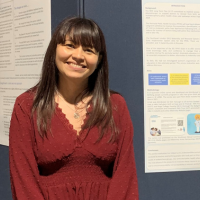
 April 2024
April 2024
What do you do?
I am project manager for the South East London Local Maternity and Neonatal System. One of my projects involved setting up the perinatal pelvic health service across south east London, which is an NHS England pilot.
I have been a midwife for 16 years and I have worked in all areas of midwifery in various operational and leadership roles. My passion is to improve maternity services and I believe that an ounce of prevention is better than a pound of cure. This is why I chose to work on the pelvic health project.
Our pelvic health service aims to prevent pelvic health issues before, during and after pregnancy and improve identification and treatment. To do this, we need to help people build their knowledge and confidence in recognising and managing their pelvic health conditions. Our service offers personalised support for women and birthing people and health care professionals.
The service won a partnership and team working award from the Royal College of Midwives, which I am extremely proud about. The award exemplifies how important it is that midwifes and physiotherapists are able to work together in this service to improve care for people who have given birth.
What interested you about pelvic health?
Pelvic health issues are common, but not normal. Yet we live in a culture that accepts and normalises incontinence. Research shows that up to 1 in 3 women experience urinary incontinence in the first year after giving birth, and up to 75% of these women continue to experience this in the following 12 years after giving birth. Additionally, 1 in 10 women experience faecal incontinence and 1 in 12 women will have a pelvic organ prolapse. This means that over 10,000 women a year could be affected by pelvic health problems after giving birth. The true number is not known given the taboo around this issue. On a recent survey we conducted across south east London, only 27% of women had the courage to raise these issues with a healthcare professional.
As health care professionals, we have a responsibility to ensure that pelvic floor symptoms are discussed at every opportunity, especially after giving birth. Our pelvic health physiotherapists and midwives also provide training and support for local clinicians, including GPs and midwives.
What is your proudest moment?
Engaging with women and birthing people in our local areas to find out their personal experiences. We really strived to include everyone in our local communities – for example we went to the Lewisham Islamic centre, and we spoke with people on the refugee resettlement programme. By working hard to engage people who are often not heard, we were able to gather views and input from right across the diverse communities living in south east London. This was really, really important to help identify and address health inequalities. We even held sessions in Spanish, as there is a big Latin-American community in south London. I am from Colombia myself so had an advantage here!
We found that women and birthing people have the same needs and wants in terms of pelvic health, but they unfortunately face many barriers including lack of understanding about NHS health care systems, and lack of information in their own language. This is why we have collaborated with physiotherapists across London to develop videos on pelvic health that have been translated into multiple languages.
Why did you become a midwife?
I became a midwife by accident! We do not have midwives back home in Colombia. I met a midwife in a social event who told me all about her work. I was really inspired and volunteered in my local maternity unit for some time before embarking on my midwifery journey. I had to do a year of prep work as all of my GCSEs were in Spanish, so I attended my local college to complete an access to nursing course. I did both my diploma and degree in midwifery at King's College University and I have completed a masters in business administration. I am now a chartered manager with the Chartered Management Institute. I still love working clinically, and do some shifts on the labour ward at St Thomas' Hospital. It really has been an amazing journey for me, so I am glad I fell into it by accident.
Further information
Pelvic health classes are available for women and birthing people accessing maternity care at Guy's and St Thomas' who are at risk of pelvic floor dysfunction.
Find out more about pelvic health during and after pregnancy on the Guy's and St Thomas' website.
Find out more about the South East London Local Maternity and Neonatal System.

Thank you to the children and young people who have so brilliantly illustrated our blog pages.